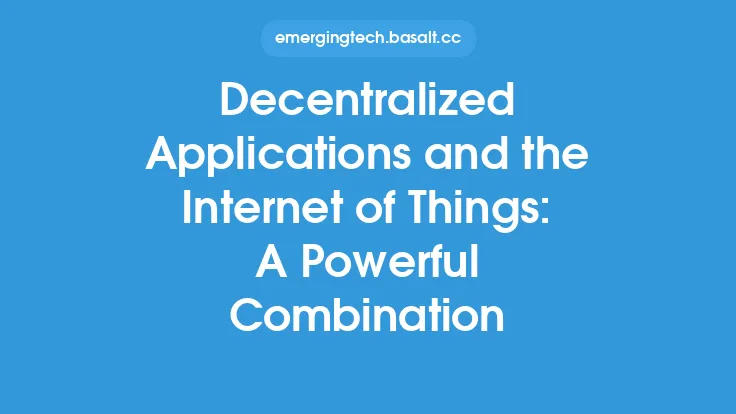The concept of decentralized applications, also known as dApps, has been around for several years, but it wasn't until the advent of blockchain technology that they started to gain traction. The idea of creating applications that operate on a decentralized network, rather than a centralized server, has been a topic of interest for developers and entrepreneurs alike. In this article, we will delve into the evolution of decentralized applications, from their conceptual beginnings to their current state of development.
Introduction to Decentralized Applications
Decentralized applications are software programs that operate on a decentralized network, such as a blockchain. They are designed to be autonomous, meaning that they can function without the need for a central authority or intermediary. This is achieved through the use of smart contracts, which are self-executing contracts with the terms of the agreement written directly into lines of code. Decentralized applications have the potential to revolutionize the way we interact with the internet, enabling a more secure, transparent, and censorship-resistant digital world.
History of Decentralized Applications
The concept of decentralized applications dates back to the early 2000s, when the idea of peer-to-peer networking was first introduced. However, it wasn't until the launch of the Ethereum blockchain in 2015 that decentralized applications started to gain mainstream attention. Ethereum's smart contract functionality enabled developers to build decentralized applications on top of the blockchain, paving the way for a new era of decentralized development. Since then, numerous other blockchain platforms have emerged, each with their own unique features and capabilities.
Key Characteristics of Decentralized Applications
Decentralized applications have several key characteristics that distinguish them from traditional centralized applications. These include:
- Decentralized governance: Decentralized applications are governed by a community of users, rather than a central authority.
- Open-source code: Decentralized applications are typically open-source, meaning that the code is available for anyone to view and modify.
- Autonomous operation: Decentralized applications can function autonomously, without the need for human intervention.
- Censorship resistance: Decentralized applications are resistant to censorship, as they operate on a decentralized network that is not controlled by a single entity.
- Transparency: Decentralized applications are transparent, as all transactions and interactions are recorded on a public ledger.
Blockchain Platforms for Decentralized Applications
Several blockchain platforms have emerged in recent years, each with their own unique features and capabilities. Some of the most popular blockchain platforms for decentralized applications include:
- Ethereum: Ethereum is one of the most widely used blockchain platforms for decentralized applications, with a large community of developers and a wide range of tools and resources available.
- Polkadot: Polkadot is a decentralized platform that enables interoperability between different blockchain networks, allowing developers to build decentralized applications that can interact with multiple chains.
- Solana: Solana is a fast and scalable blockchain platform that is designed for decentralized applications, with a focus on gaming and other high-performance use cases.
- Binance Smart Chain: Binance Smart Chain is a blockchain platform developed by the Binance cryptocurrency exchange, with a focus on decentralized finance (DeFi) and other applications.
Use Cases for Decentralized Applications
Decentralized applications have a wide range of potential use cases, including:
- Decentralized finance (DeFi): Decentralized applications can be used to create decentralized financial systems, such as lending platforms and stablecoins.
- Gaming: Decentralized applications can be used to create decentralized gaming platforms, with features such as in-game item ownership and decentralized marketplaces.
- Social media: Decentralized applications can be used to create decentralized social media platforms, with features such as censorship-resistant content sharing and community governance.
- Supply chain management: Decentralized applications can be used to create decentralized supply chain management systems, with features such as transparent tracking and authentication.
Challenges and Limitations of Decentralized Applications
While decentralized applications have the potential to revolutionize the way we interact with the internet, they also face several challenges and limitations. These include:
- Scalability: Decentralized applications can be slow and cumbersome, due to the need for consensus mechanisms and other decentralized features.
- User experience: Decentralized applications can be difficult to use, due to the complexity of blockchain technology and the need for users to manage their own private keys and wallets.
- Regulation: Decentralized applications are often unregulated, which can make it difficult for developers to navigate the legal and regulatory landscape.
- Security: Decentralized applications can be vulnerable to security risks, such as smart contract bugs and 51% attacks.
Future of Decentralized Applications
Despite the challenges and limitations, the future of decentralized applications looks bright. As blockchain technology continues to evolve and improve, we can expect to see more widespread adoption of decentralized applications across a range of industries and use cases. Some potential future developments include:
- Improved scalability: The development of more scalable blockchain platforms and technologies, such as sharding and off-chain transactions.
- Simplified user experience: The creation of more user-friendly decentralized applications, with features such as intuitive interfaces and seamless onboarding processes.
- Increased regulation: The development of clearer regulations and guidelines for decentralized applications, which can help to build trust and confidence in the industry.
- Greater adoption: The widespread adoption of decentralized applications across a range of industries and use cases, from finance and gaming to social media and supply chain management.





